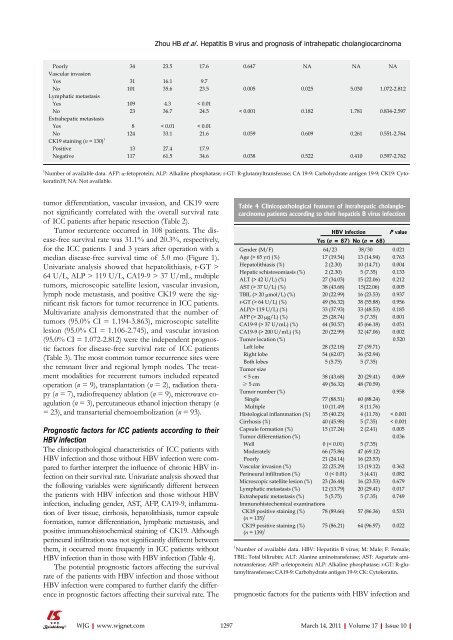10 - World Journal of Gastroenterology
10 - World Journal of Gastroenterology
10 - World Journal of Gastroenterology
You also want an ePaper? Increase the reach of your titles
YUMPU automatically turns print PDFs into web optimized ePapers that Google loves.
Zhou HB et al . Hepatitis B virus and prognosis <strong>of</strong> intrahepatic cholangiocarcinoma<br />
Poorly 34 23.5 17.6 0.647 NA NA NA<br />
Vascular invasion<br />
Yes 31 16.1 9.7<br />
No <strong>10</strong>1 35.6 23.5 0.005 0.025 5.030 1.072-2.812<br />
Lymphatic metastasis<br />
Yes <strong>10</strong>9 4.3 < 0.01<br />
No 23 36.7 24.5 < 0.001 0.182 1.781 0.834-2.597<br />
Extrahepatic metastasis<br />
Yes 8 < 0.01 < 0.01<br />
No 124 33.1 21.6 0.059 0.609 0.261 0.551-2.764<br />
CK19 staining (n = 130) 1<br />
Positive 13 27.4 17.9<br />
Negative 117 61.5 34.6 0.038 0.522 0.4<strong>10</strong> 0.597-2.762<br />
1<br />
Number <strong>of</strong> available data. AFP: a-fetoprotein; ALP: Alkaline phosphatase; r-GT: R-glutamyltransferase; CA 19-9: Carbohydrate antigen 19-9; CK19: Cytokeratin19;<br />
NA: Not available.<br />
tumor differentiation, vascular invasion, and CK19 were<br />
not significantly correlated with the overall survival rate<br />
<strong>of</strong> ICC patients after hepatic resection (Table 2).<br />
Tumor recurrence occurred in <strong>10</strong>8 patients. The disease-free<br />
survival rate was 31.1% and 20.3%, respectively,<br />
for the ICC patients 1 and 3 years after operation with a<br />
median disease-free survival time <strong>of</strong> 5.0 mo (Figure 1).<br />
Univariate analysis showed that hepatolithiasis, r-GT ><br />
64 U/L, ALP > 119 U/L, CA19-9 > 37 U/mL, multiple<br />
tumors, microscopic satellite lesion, vascular invasion,<br />
lymph node metastasis, and positive CK19 were the significant<br />
risk factors for tumor recurrence in ICC patients.<br />
Multivariate analysis demonstrated that the number <strong>of</strong><br />
tumors (95.0% CI = 1.194-3.863), microscopic satellite<br />
lesion (95.0% CI = 1.<strong>10</strong>6-2.745), and vascular invasion<br />
(95.0% CI = 1.072-2.812) were the independent prognostic<br />
factors for disease-free survival rate <strong>of</strong> ICC patients<br />
(Table 3). The most common tumor recurrence sites were<br />
the remnant liver and regional lymph nodes. The treatment<br />
modalities for recurrent tumors included repeated<br />
operation (n = 9), transplantation (n = 2), radiation therapy<br />
(n = 7), radi<strong>of</strong>requency ablation (n = 9), microwave coagulation<br />
(n = 3), percutaneous ethanol injection therapy (n<br />
= 23), and transarterial chemoembolization (n = 93).<br />
Prognostic factors for ICC patients according to their<br />
HBV infection<br />
The clinicopathological characteristics <strong>of</strong> ICC patients with<br />
HBV infection and those without HBV infection were compared<br />
to further interpret the influence <strong>of</strong> chronic HBV infection<br />
on their survival rate. Univariate analysis showed that<br />
the following variables were significantly different between<br />
the patients with HBV infection and those without HBV<br />
infection, including gender, AST, AFP, CA19-9, inflammation<br />
<strong>of</strong> liver tissue, cirrhosis, hepatolithiasis, tumor capsule<br />
formation, tumor differentiation, lymphatic metastasis, and<br />
positive immunohistochemical staining <strong>of</strong> CK19. Although<br />
perineural infiltration was not significantly different between<br />
them, it occurred more frequently in ICC patients without<br />
HBV infection than in those with HBV infection (Table 4).<br />
The potential prognostic factors affecting the survival<br />
rate <strong>of</strong> the patients with HBV infection and those without<br />
HBV infection were compared to further clarify the difference<br />
in prognostic factors affecting their survival rate. The<br />
Table 4 Clinicopathological features <strong>of</strong> intrahepatic cholangiocarcinoma<br />
patients according to their hepatitis B virus infection<br />
HBV infection<br />
Yes (n = 87) No (n = 68)<br />
P value<br />
(89.66) 57 (86.36) 0.531<br />
Gender (M/F) 64/23 38/30 0.021<br />
Age (> 65 yr) (%) 17 (19.54) 13 (14.94) 0.763<br />
Hepatolithiasis (%) 2 (2.30) <strong>10</strong> (14.71) 0.004<br />
Hepatic schistosomiasis (%) 2 (2.30) 5 (7.35) 0.133<br />
ALT (> 42 U/L) (%) 27 (34.03) 15 (22.06) 0.212<br />
AST (> 37 U/L) (%) 38 (43.68) 15(22.06) 0.005<br />
TBIL (> 20 μmol/L) (%) 20 (22.99) 16 (23.53) 0.937<br />
r-GT (> 64 U/L) (%) 49 (56.32) 38 (55.88) 0.956<br />
ALP(> 119 U/L) (%) 33 (37.93) 33 (48.53) 0.185<br />
AFP (> 20 μg/L) (%) 25 (28.74) 5 (7.35) 0.001<br />
CA19-9 (> 37 U/mL) (%) 44 (50.57) 45 (66.18) 0.051<br />
CA19-9 (> 200 U/mL) (%) 20 (22.99) 32 (47.06) 0.002<br />
Tumor location (%) 0.520<br />
Left lobe 28 (32.18) 27 (39.71)<br />
Right lobe 54 (62.07) 36 (52.94)<br />
Both lobes 5 (5.75) 5 (7.35)<br />
Tumor size<br />
< 5 cm 38 (43.68) 20 (29.41) 0.069<br />
≥ 5 cm 49 (56.32) 48 (70.59)<br />
Tumor number (%) 0.958<br />
Single 77 (88.51) 60 (88.24)<br />
Multiple <strong>10</strong> (11.49) 8 (11.76)<br />
Histological inflammation (%) 35 (40.23) 4 (11.76) < 0.001<br />
Cirrhosis (%) 40 (45.98) 5 (7.35) < 0.001<br />
Capsule formation (%) 15 (17.24) 2 (2.41) 0.005<br />
Tumor differentiation (%) 0.036<br />
Well 0 (< 0.01) 5 (7.35)<br />
Moderately 66 (75.86) 47 (69.12)<br />
Poorly 21 (24.14) 16 (23.53)<br />
Vascular invasion (%) 22 (25.29) 13 (19.12) 0.362<br />
Perineural infiltration (%) 0 (< 0.01) 3 (4.41) 0.082<br />
Microscopic satellite lesion (%) 23 (26.44) 16 (23.53) 0.679<br />
Lymphatic metastasis (%) 12 (13.79) 20 (29.41) 0.017<br />
Extrahepatic metastasis (%) 5 (5.75) 5 (7.35) 0.749<br />
Immunohistochemical examinations<br />
CK18 positive staining (%) 78<br />
(n = 135) 1<br />
CK19 positive staining (%)<br />
(n = 139) 1 75 (86.21) 64 (96.97) 0.022<br />
1<br />
Number <strong>of</strong> available data. HBV: Hepatitis B virus; M: Male; F: Female;<br />
TBIL: Total bilirubin; ALT: Alanine aminotransferase; AST: Aspartate aminotransferase;<br />
AFP: a-fetoprotein; ALP: Alkaline phosphatase; r-GT: R-glutamyltransferase;<br />
CA19-9: Carbohydrate antigen 19-9; CK: Cytokeratin.<br />
prognostic factors for the patients with HBV infection and<br />
WJG|www.wjgnet.com<br />
1297 March 14, 2011|Volume 17|Issue <strong>10</strong>|

















